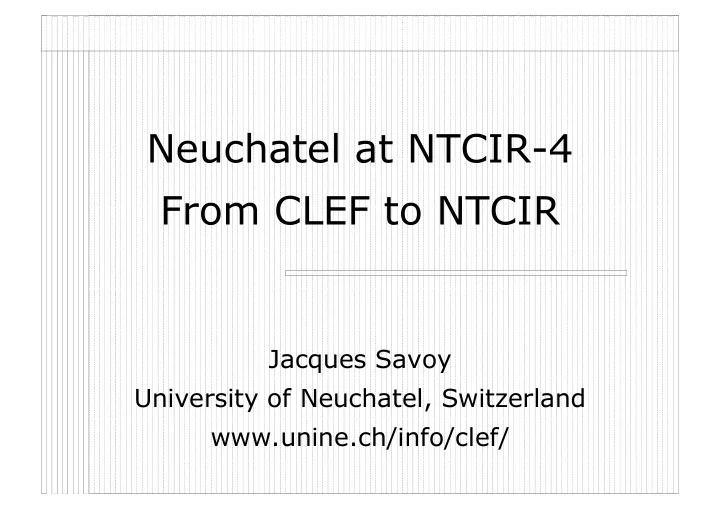

Neuchatel at NTCIR-4 From CLEF to NTCIR Jacques Savoy University of Neuchatel, Switzerland www.unine.ch/info/clef/
From CLEF to NTCIR European languages, Asian languages, different languages but same IR problems? one byte = one char But limited set of char same indexing? space between words same search and translation scheme? different writings
Indexing methods E: Words CJK: bigrams Stopword list Stoplist Stemming No stemming SMART system In K, 80% of nouns are composed of two characters (Lee et al., IP&M, 1999)
Example in Chinese
IR models Vector-space Probabilistic Lnu-ltc Okapi tf-idf (ntc-ntc) Prosit or deviation from binary (bnn-bnn) randomness
Monolingual evaluation Model English Korean T D T D Okapi 0.3132 0.2992 0.4033 0.3475 Prosit 0.2997 0.2871 0.3882 0.3010 Lnu-ltc 0.3069 0.3139 0.4193 0.4001 tf-idf 0.1975 0.2171 0.3245 0.3406 binary 0.1562 0.1262 0.1944 0.0725
Monolingual evaluation Model English Korean T D T D Okapi 0.3132 0.2992 0.4033 0.3475 +PRF 0.3594 0.3181 0.4960 0.4441 +15% +6% +23% +28% Prosit 0.2997 0.2871 0.3882 0.3010 +PRF 0.3731 0.3513 0.4875 0.4257 +25% +22% +26% +41%
Data Fusion K K K by SE1 by SE2 by SE3 <– Data fusion
Data fusion 1 KR120 1.2 1 KR043 0.8 1 KR050 1.6 2 KR120 0.75 2 KR005 1.3 2 KR200 1.0 3 KR050 0.7 3 KR055 0.65 3 KR120 0.9 4 KR705 0.6 4 … 4 … … 1 KR… 2 KR… 3 KR… 4 ….
Data fusion Round-robin (baseline) Sum RSV (Fox et al., TREC-2) Normalize (divide by the max) Z-score
Z-score normalization Compute the mean µ and 1 KR120 1.2 standard deviation σ 2 KR200 1.0 3 KR050 0.7 New score = 4 KR765 0.6 ((old score- µ ) / σ ) + δ … … 1 KR120 7.0 2 KR200 5.0 3 KR050 2.0 4 KR765 1.0 …
Monolingual (data fusion) Korean T (4 SE) TDNC (2 SE) best single 0.4868 0.5141 Round-robin 0.4737 0.5047 SumRSV 0.5044 0.5030 Norm max 0.5084 0.5045 Z-score 0.5074 0.5023 Z-score wt 0.5078 0.5058
Monolingual evaluation (C) Model Chinese-unigram Chinese-bigram T D T D Okapi 0.1667 0.1198 0.1755 0.1576 Prosit 0.1452 0.0850 0.1658 0.1467 Lnu-ltc 0.1834 0.1484 0.1794 0.1609 tf-idf 0.1186 0.1136 0.1542 0.1507 binary 0.0431 0.0112 0.0796 0.0686
Monolingual evaluation (C) Model Chinese-unigram Chinese-bigram T D T D Okapi 0.1667 0.1198 0.1755 0.1576 +PRF 0.1884 0.1407 0.2004 0.1805 +13% +17% +14% +15% Prosit 0.1452 0.0850 0.1658 0.1467 +PRF 0.1659 0.1132 0.2140 0.1987 +14% +33% +29% +35%
Monolingual evaluation (J) Model Bigram (kanji,kata) Bigram (kanji) T D T D Okapi 0.2873 0.2821 0.2972 0.2762 Prosit 0.2637 0.2573 0.2734 0.2517 Lnu-ltc 0.2701 0.2740 0.2806 0.2718 tf-idf 0.2104 0.2087 0.2166 0.2101 binary 0.1743 0.1741 0.1703 0.1105
Monolingual evaluation (J) Model Bigram (kanji,kata) Bigram (kanji) T D T D Okapi 0.2873 0.2821 0.2972 0.2762 +PRF 0.3259 0.3331 0.3514 0.3200 +13% +18% +18% +16% Prosit 0.2637 0.2573 0.2734 0.2517 +PRF 0.3396 0.3394 0.3495 0.3218 +29% +32% +28% +28%
Translation resources Machine-readable dictionaries Babylon Evdict Machine translation services WorldLingo BabelFish Parallel and/or comparable corpora (not used in this evaluation campaign)
Bilingual evaluation E->C/J/K T Chinese Japanese Korean Okapi bigram bigram k&k bigram Manual 0.1755 0.2873 0.4033 Babylon 1 0.0458 0.0946 0.1015 Lingo 0.0794 0.1951 0.1847 Babelfish 0.0360 0.1952 0.1855 Combined 0.0854 0.2174 0.1848
Bilingual evaluation E->C/J/K T Chinese Japanese Korean bigram bigram k&k bigram Manual 0.1755 0.2873 0.4033 0.2174 0.1848 Okapi 0.0854 0.2733 0.2397 +PRF 0.1039 Prosit 0.0817 0.1973 0.1721 +PRF 0.1213 0.2556 0.2326
Multilingual IR E->CJKE Create a common index Document translation (DT) Search on each language and merge the result lists (QT) Mix QT and DT No translation
Merging problem C E J K <–– Merging
Multilingual IR (merging) Round-robin (baseline) Raw-score merging Normalize (by the max) Z-score Logistic regression
Test-collection NTCIR-4 E C J K size 619 MB 490 MB 733 MB 370 MB doc 347550 381681 596058 254438 mean 96.6 363.4 114.5 236.2 topic 58 59 55 57 rel. 35.5 19 88 43
Multilingual evaluation CJE T (auto) T (manual) Round-robin 0.1564 0.2204 Raw-score 0.1307 0.2035 Norm max 0.1654 0.2222 Biased RR 0.1413 0.2290 Z-score wt 0.1719 0.2370
Multilingual evaluation CJKE T (auto) T (manual) Round-robin 0.1419 0.2371 Raw-score 0.1033 0.1564 Norm max 0.1411 0.2269 Biased RR 0.1320 0.2431 Z-score 0.1446 0.2483
Conclusions (monolingual) From CLEF to NTCIR The best IR model seems to be language-dependant (Okapi in CLEF) Pseudo-relevance feedback improves the initial search Data fusion (yes, with shot queries limited in CLEF)
Conclusions (bilingual) From CLEF to NTCIR Translation resources freely available produce a poor IR performance (differs from CLEF) Improvement by Combining translations (not here, yes in CLEF) Pseudo-relevance feedback (as in CLEF) Data fusion (not clear)
Conclusions (multilingual) From CLEF to NTCIR Selection and merging are still hard problems (as in CLEF) Z-score seems to produce good IR performance over different conditions (as in CLEF)
Recommend
More recommend